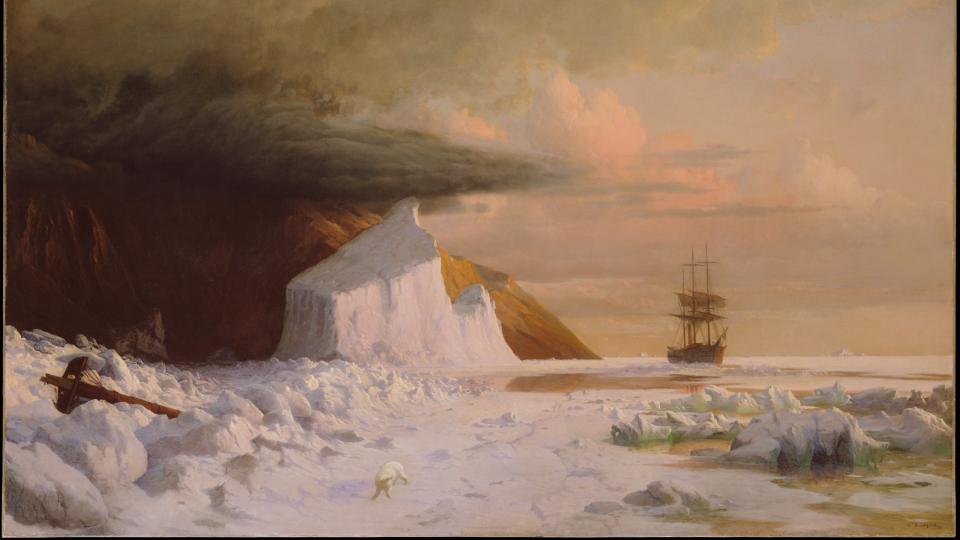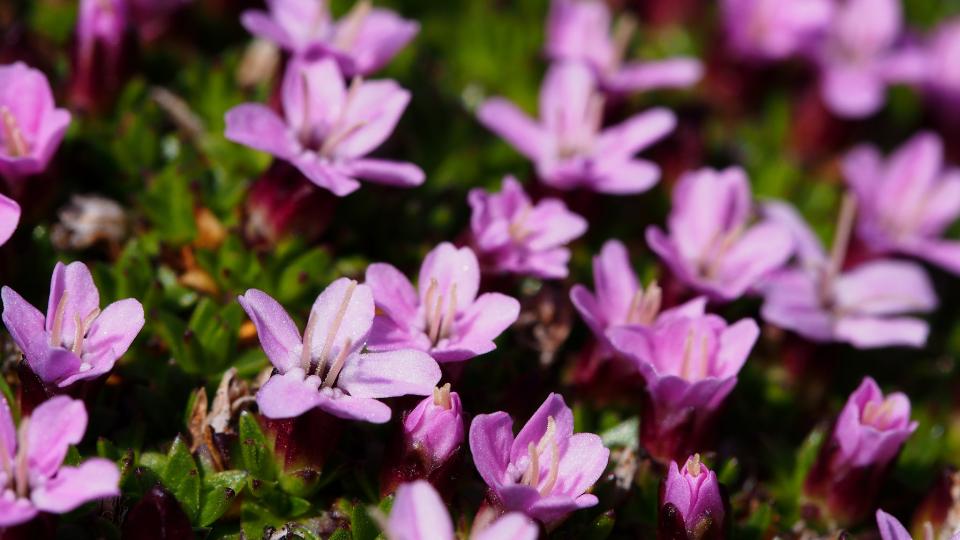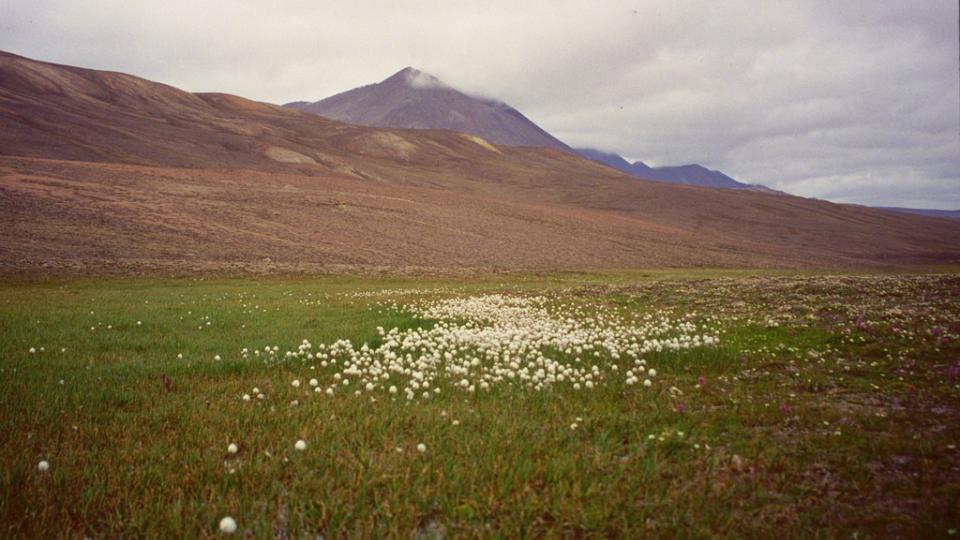Many of us “southerners” or Qallunaat, as we are commonly referred to in Inuit vocabulary, imagine the Arctic lands as a barren snowscape. At the historic roots of this perception, I see the visual culture of Arctic exploration throughout a long nineteenth century, which represented the Canadian Arctic as devoid of its diverse flora. How could explorers misrepresent the Arctic as desolate when iconic tundra plants like Labrador tea, cottongrass, or wildflowers bloom seasonally? I situate Qallunaat exploration in wider Indigenous territories of what we now call Canada in order to challenge the colonial perception of these “new” lands and settler uses of native technologies. Understanding how explorers framed the Arctic as lifeless helps us comprehend perceptions of it today, which is crucial since climate change renders the polar region increasingly important in Qallunaat-settler geopolitics and extractivism.

William Bradford, An Arctic Summer: Boring Through the Pack in Melville Bay, 1871. Oil on canvas. Held by the Met Fifth Avenue, New York.
William Bradford, An Arctic Summer: Boring Through the Pack in Melville Bay, 1871. Oil on canvas. Held by the Met Fifth Avenue, New York.
Courtesy of the Met Fifth Avenue.
Accessed on 28 February 2019. Click here to view source.
 This work is licensed under a Creative Commons Public Domain Mark 1.0 License.
This work is licensed under a Creative Commons Public Domain Mark 1.0 License.
On 5 May 1855, Hudson’s Bay Company fur trader James Green Stewart (1825–1890) wrote in his diary while searching for the missing Franklin expedition on the Back River: “the scenery here is a little diversified by the round hills and green colour of the moss at a distance one would fancy it was grass. The dwarf birch too adds a little to the deception.” While the tundra vegetation was playing tricks on Stewart, the larger deception was how explorers, publishers, and newspapers represented the Arctic to the reading public. Simplistic images of snow and ice accompanied romanticized narratives. Robert David likens Europeans trapped in an Arctic “cultural creation” to the phenomenon of Orientalism.
This misrepresentation came at the expense of the environment, in favor of a narrative of Western-Qallunaat technological superiority and to exaggerate white masculinity’s accomplishments. This barrenness bolstered explorers’ presence in the Inuit homeland, and the construction of vastness fueled Qallunaat interests like imperial sovereignty, searching for the Northwest Passage, and extractive industries of whaling and fishing.

Moss Campion (Silene acaulis or Aupilattunguangujuq).
Moss Campion (Silene acaulis or Aupilattunguangujuq).
Photograph by Fiona Paton, 2018.
Accessed via Flickr on 28 February 2019. Click here to view source.
 This work is licensed under a Creative Commons Attribution-NonCommercial-NoDerivs 2.0 Generic License.
This work is licensed under a Creative Commons Attribution-NonCommercial-NoDerivs 2.0 Generic License.
Ironically, explorers omitted plant life from their images, even while botanical samples were collected on these same voyages. Historian Trevor Levere raises this contradiction and places botanists William J. Hooker (1785–1865) and his son Joseph Dalton Hooker (1817–1911) at the center of imperial scrutiny. Both were well-connected with Victorian-era Arctic explorers through correspondence; e.g., a botanic drawing of Coptis aspleniifolia or Fernleaf Goldthread, a plant native to northern British Columbia and Alaska, served as the background for a letter between William Hooker and the explorer John Richardson (1787–1865). The drive to understand the world through the ascendant sciences had explorers like Richardson, James Ross, John Franklin, and many others boasting about their specimens on returning to the metropole.
The botanical absence in popular Arctic images occurred as environmental specificity was redirected to emphasize accomplishment, grandeur, and technological superiority. Representations routinely show men traversing the land and ships sailing among icebergs. Thus, they break the norms of the unpeopled landscape tradition familiar in Canadian culture. Richard Dryer and Scott Morgensen both locate white-colonial masculinity around achievement and enterprise. However, the explorers’ success was dubious and reliant on Indigenous expertise. Heather Igloliorte describes Inuit knowledge (or Inuit Qaujimajatuqngit) as “living technology … knowledge embedded in practice.” These Indigenous technologies, like the Inuit dogsled, were crucial for expedition success. An 1836 newspaper clipping from the HBC archival holdings demonstrates this when George Back comments on his upcoming expedition from Lake Winnipeg to Great Slave Lake: “this track is well known to the Chipewayan Indians, whose authority is much more to be dependent upon than the public hitherto been led to believe.” Historian Ken McGoogan highlights how explorers’ accomplishments continually came about with the aid of Indigenous people and their technology, which disrupts the notion that white men succeeded in exploration by their own will, hard work, or technological means.

Arctic Cotton Grass in a Nunavut mountain valley.
Arctic Cotton Grass in a Nunavut mountain valley.
Photograph by Judith Slein, 1999.
Accessed via Flickr on 28 February 2019. Click here to view source.
 This work is licensed under a Creative Commons Attribution-NonCommercial-ShareAlike 2.0 Generic License.
This work is licensed under a Creative Commons Attribution-NonCommercial-ShareAlike 2.0 Generic License.
Steve Garlick has theorized that masculinity itself must be understood as a technology of domination: “Technology is associated with the masculine because masculinity itself is a (modern) technology for the embodiment and control of nature.” Experienced on terra firma and at extracting wealth from the sea, men of industry like William Penny (1809–1892), founder of the whaling enterprise the Aberdeen Arctic Company, exemplify this. Beyond gender, I refute the idea that only white Qallunaat-settler men can claim their tools as technology. Contrary to such a notion, expedition culture constantly relied on Indigenous people, their tools, and knowledge for their survival and success. John Richardson left advice to the departing Franklin search expeditions that European boots would prove useless, inviting frost bite and hypothermia. He recommended trading for kamik boots and learning how to fashion snow goggles. Likewise, in 1771 George Cartwright lost his Governor Surgeon to the cold in northern Labrador, later remarking at the warmth of being in an igloo lit only by a stone oil lamp or qulliq.
On account of the Arctic’s remoteness, its perception by outsiders has always been mediated heavily through contemporary images or in historic print culture. Today, the north remains a romantic symbol. Its perception is important to constructed narratives complicit in inaction on climate change, settler-colonial nation-state sovereignty, resource extraction, or assaults on sustainable practices like seal harvesting. These Qallunaat myths around the Arctic environment and Inuit life are well documented by Chelsea Vowel and Emilie Cameron, referencing Inuit relocations and other colonial violences. The region remains a vibrant Inuit homeland with a thriving and delicate animal and botanical ecosystem, one which has been largely erased in colonial landscape historiography.
How to cite
Gismondi, Chris. “How the Arctic Became White: Victorian Explorers and the Erasure of Botany in the Canadian Arctic.” Environment & Society Portal, Arcadia (Spring 2019), no. 16. Rachel Carson Center for Environment and Society. doi.org/10.5282/rcc/8594.
ISSN 2199-3408
Environment & Society Portal, Arcadia
 This work is licensed under a Creative Commons Attribution 4.0 International License.
This work is licensed under a Creative Commons Attribution 4.0 International License.
2019 Chris Gismondi
This refers only to the text and does not include any image rights.
Please click on the images to view their individual rights status.
- David, Robert G. The Arctic in the British Imaginary: 1818–1914. Manchester: Manchester University Press, 2000.
- Dyer, Richard. White: Essays on Race and Culture. London: Routledge, 1997.
- Garlick, Steve. The Nature of Masculinity: Critical Theory, New Materialisms, and Technologies of Embodiment. Vancouver: University of British Columbia Press, 2016.
- Igloliorte, Heather. “Arctic Culture / Global Indigeneity.” In Negotiations in a Vacant Lot: Studying the Visual in Canada, edited by Lynda Jessup, Erin Morton, and Kirsty Robertson. Montreal: McGill-Queen's University Press, 2014.
- Levere, Trevor H. Science and the Canadian Arctic: A Century of Exploration, 1818–1918. Cambridge: Cambridge University Press, 1993.
- McGoogan, Ken. Dead Reckoning: The Untold Story of the Northwest Passage. Toronto: Harper Collins, 2017.
- Morgensen, Scott L. “Cutting to the Roots of Colonial Masculinity.” In Indigenous Men and Masculinities: Legacies, Identities, Regeneration, edited by Kim Anderson and Robert Alexander Innes. Winnipeg: University of Manitoba Press, 2015.








